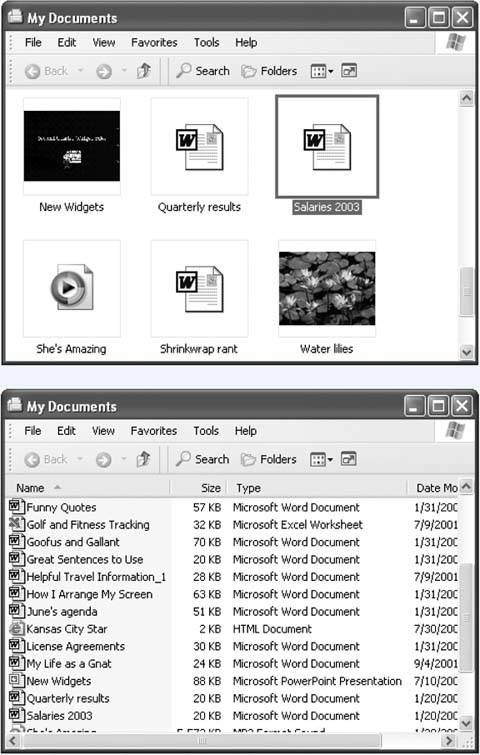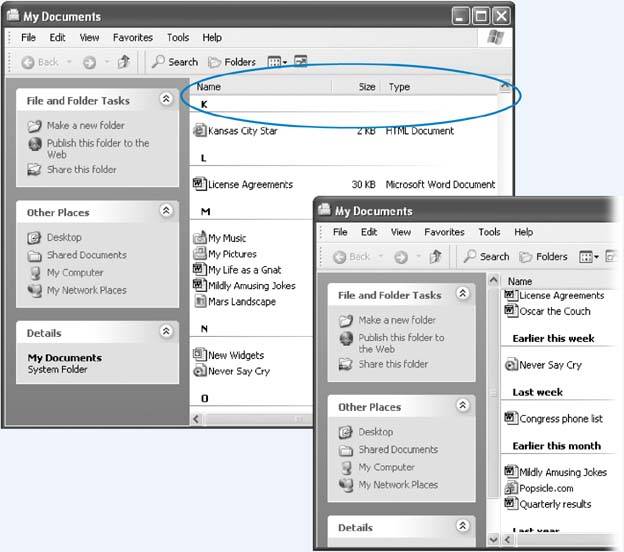Section 3.2. The Desktop Window Overhaul
3.2. The Desktop Window OverhaulWindows' windows look just fine straight from the factory: all the edges are straight, and the text is perfectly legible. Still, if you're going to stare at this computer screen for half of your waking hours, you may as well investigate some of the ways these windows can be enhanced for better looks and greater efficiency. As it turns out, there's no end to the tweaks Microsoft lets you perform. 3.2.1. Icon and List ViewsYou can view the files and folders in a desktop window in any of several ways: as small icons, jumbo icons, a tidy list, and so on. Each window remembers its own view settings. To change the view of a particular open window, choose one of these commands from its View menu (or from the little icon-filled desktop-window icon on the toolbar): Filmstrip, Thumbnails, Tiles, Icons, List, or Details. Here's a brief rundown:
Some of these views are new in Windows XP. Filmstrip view, for example, is a home run for anyone with a digital camera or scanner. It turns the folder window into a slide show machine, complete with Next and Previous buttons beneath an enlarged picture, as well as buttons that rotate the image on the screen. (You get this view automatically when you open your My Pictures folder.) Figure 3-4. As you can see throughout this chapter, Windows lets you see your windows in many different ways. For example, Thumbnails view (top) gives you a preview of what you're clickingand gives your mouse a nice, big target. Details view (bottom), by contrast, shows you the greatest amount of information about each item, making it dense and harder to read. Tip: In Filmstrip view, try right-clicking inside the large image of your photo. The resulting shortcut menu offers a number of very useful options, including Rotate commands, "Set as Desktop Background," and Send To (which lets you fire off the picture to somebody by email). 3.2.1.1. Changing the sorting orderWindows XP starts out arranging the icons alphabetically in two different groups. Folders come first, followed by the list of loose files in a second group . But you don't have to be content with an alphabetical list. Windows XP is wildly flexible in this regard, letting you sort a window's contents in any of 32 ways. To change the sorting criterion, choose View
Tip: You can't reverse the sort order of your icons (from Z to A, for example), except in Details view, described next. 3.2.1.2. Manipulating the Details viewYou gotta love Details view. Clearly, Microsoft does: it's endowed Details view with much more flexibility and power than the other views. First, there's the obvious advantage of being able to see the size and date of the objects in neat columns, as shown in Figure 3-4. Second, you can sort the contents by file size, type, or date simply by clicking the appropriate column heading. Click the same heading again to reverse the sort order. Third, you can rearrange the column sequence just by dragging their headings horizontally. You can adjust column widths just by dragging the vertical divider bar (between column headings) from side to side. Finally, you can manipulate the columns in a number of ways:
Once you've opened the Choose Details window, you could change the width of a column by editing the number at the bottom in the "Width of selected column (in pixels)" text boxbut that's for geeks . It's much more natural to adjust column widths just by dragging the vertical divider bar. 3.2.2. Standard Folder ViewsNow that you've twiddled and tweaked your system windows into a perfectly efficient configuration, you needn't go through the same exercises for each folder. Windows XP can immortalize your changes as the standard setting for all your windows. Choose Tools At this point, all of your disk and folder windows open up with the same view, sorting method, and so on. You're still free to override those standard settings on a window-by-window basis, however. And if you change your mind again , seeking to make all of your maverick folder windows snap back into line with the original standard settings, choose Tools |
EAN: 2147483647
Pages: 162
- Integration Strategies and Tactics for Information Technology Governance
- Measuring and Managing E-Business Initiatives Through the Balanced Scorecard
- Measuring ROI in E-Commerce Applications: Analysis to Action
- Technical Issues Related to IT Governance Tactics: Product Metrics, Measurements and Process Control
- Governing Information Technology Through COBIT
 Arrange Icons By, and then choose from the drop-down menu. The sorting possibilities listed here depend on which
Arrange Icons By, and then choose from the drop-down menu. The sorting possibilities listed here depend on which 